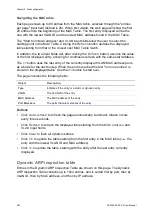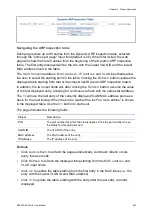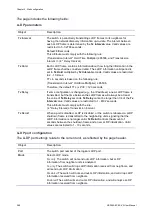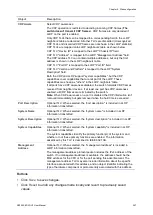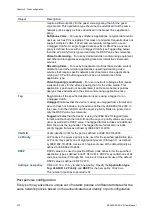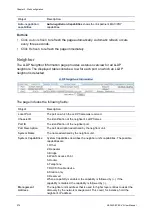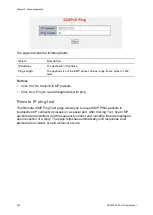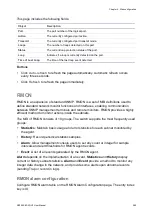
Chapter 4: Web configuration
NS3552-8P-2S-V2 User Manual
275
Object
Description
Voice
– For use by dedicated IP Telephony handsets and other similar
appliances supporting interactive voice services. These devices are typically
deployed on a separate VLAN for ease of deployment and enhanced
security by isolation from data applications.
Voice Signaling
– For use in network topologies that require a different
policy for the voice signaling than for the voice media.
Guest Voice
– Supports a separate limited feature–set voice service for
guest users and visitors with their own IP Telephony handsets and other
similar appliances supporting interactive voice services.
Guest Voice Signaling
– For use in network topologies that require a
different policy for the guest voice signaling than for the guest voice media.
Softphone Voice
– For use by softphone applications on typical data-centric
devices, such as PCs or laptops.
Video Conferencing
– For use by dedicated video conferencing equipment
and other similar appliances supporting real–time interactive video/audio
services.
Streaming Video
– For use by broadcast or multicast based video content
distribution and other similar applications supporting streaming video
services that require specific network policy treatment. Video applications
relying on TCP with buffering would not be an intended use of this
application type.
Video Signaling
– For use in network topologies that require a separate
policy for the video signaling than for the video media.
Policy
Policy
indicates that an Endpoint Device wants to explicitly advertise that
the policy is required by the device. Can be either
Defined
or
Unknown
.
Unknown
: The network policy for the specified application type is currently
unknown.
Defined
: The network policy is defined.
TAG
TAG is indicating whether the specified application type is using a tagged or
an untagged VLAN. Can be
Tagged
or
Untagged
.
Untagged
: The device is using an untagged frame format and as such does
not include a tag header as defined by IEEE 802.1Q-2003.
Tagged
: The device is using the IEEE 802.1Q tagged frame format.
VLAN ID
VLAN ID is the VLAN identifier (VID) for the port as defined in IEEE 802.1Q-
2003. A value of 1 through 4094 is used to define a valid VLAN ID. A value
of 0 (Priority Tagged) is used if the device is using priority tagged frames as
defined by IEEE 802.1Q-2003, meaning that only the IEEE 802.1D priority
level is significant and the default PVID of the ingress port is used instead.
Priority
Priority is the Layer 2 priority to be used for the specified application type.
One of eight priority levels (0 through 7).
DSCP
DSCP is the DSCP value to be used to provide Diffserv node behavior for
the specified application type as defined in IETF RFC 2474. Contain one of
64 code point values (0 through 63).
Auto-negotiation
Auto-negotiation identifies if MAC/PHY auto-negotiation is supported by the
link partner.
Auto-negotiation
status
Auto-negotiation status identifies if auto-negotiation is currently enabled at
the link partner.
If
Auto-negotiation
is supported and
Auto-negotiation status
is disabled,
the 802.3 PMD operating mode will be determined by the operational MAU
type field value rather than by auto-negotiation.
Summary of Contents for NS3552-8P-2S-V2
Page 1: ...NS3552 8P 2S V2 User Manual P N 1073552 EN REV B ISS 25JAN19 ...
Page 41: ...Chapter 3 Switch management NS3552 8P 2S V2 User Manual 39 ...
Page 73: ...Chapter 4 Web configuration NS3552 8P 2S V2 User Manual 71 ...
Page 147: ...Chapter 4 Web configuration NS3552 8P 2S V2 User Manual 145 ...
Page 511: ......


